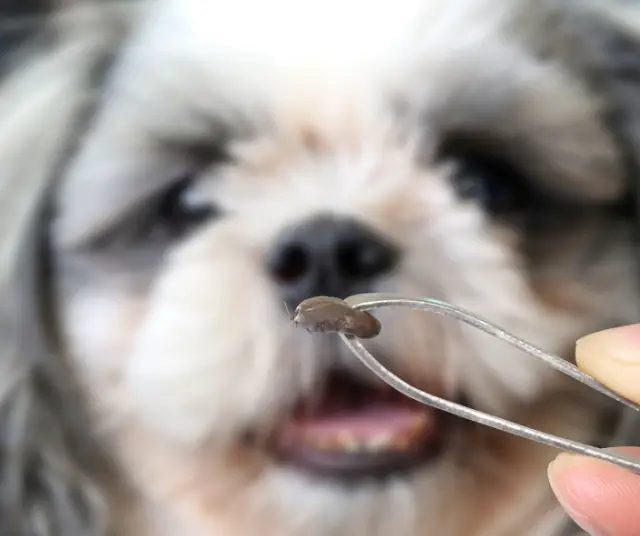Ticks are common parasites that can affect dogs, causing discomfort and, in some cases, transmitting serious diseases. Therefore, it is essential that pet owners are equipped with an effective method to remove ticks on their dogs.
Living with dogs not only implies the enjoyment of their loyal company, but also the responsibility of ensuring their overall well-being. One of the most common challenges on this journey is the presence of ticks, those tiny arachnids that, despite their size, can have significant consequences for the health of our furry friends. In this context, the urgent need arises for an effective method to eliminate ticks in dogs, addressing not only the fight against these parasites, but also focusing on prevention as a cornerstone for optimal canine care.
Prevention: The First Line of Defense
Prevention is essential in the fight against ticks. Using proper prevention methods is essential to prevent these parasites from attaching to your dog in the first place. Some effective measures include:
to. Repellent Products:
Using specific repellent products for ticks, such as collars, pipettes or sprays, can help keep these parasites at bay. Products based on ingredients such as fipronil, permethrin or selamectin are popular and effective options.
b. Controlled Environments:
Keeping your dog's environment clean and free of tall brush can significantly reduce exposure to ticks. Mowing the grass regularly and removing dense vegetation around the home are important steps.
c. Regular Review:
Performing regular checks of your dog's coat is an effective way to detect ticks early. Pay special attention to prone areas, such as ears, neck, armpits, and paws.
Early Detection: Key to Control
Early detection is crucial to prevent ticks from attaching and feeding for long periods. Here are some tips for identifying ticks on your dog:
- Visual Examination: Thoroughly examine your dog's fur for ticks. Pay attention to small bumps on the skin or red, swollen areas.
- Wearing Gloves: When checking your dog for ticks, wear gloves to protect yourself from possible bites and to make it easier to detect these tiny parasites.
- Behavioral Observation: Unusual behavior, such as excessive scratching or agitation, could indicate the presence of ticks. Observe any changes in your pet's behavior and act quickly if you notice anything out of the ordinary.
Methods to Remove Tick
When ticks are detected, it is crucial to take immediate steps to remove them and avoid potential complications. Here are effective methods to remove ticks on dogs:
Fine-Point Tweezers: Use fine-tip tweezers to gently grasp the tick near the skin and pull with a firm, steady motion. Make sure you don't leave any parts of the tick on the dog's skin.
Special Tick Hooks: Tick hooks are tools specifically designed to safely remove ticks. Select the appropriate hook based on the size of the tick and follow the manufacturer's instructions.
Essential Oils: Some essential oils, such as tea tree or lavender, have repellent properties and can help loosen the tick. Dilute the essential oil with a carrier oil and apply it before attempting extraction.
After Extraction: Important Care
The act of removing a tick from our dog marks the beginning of a crucial phase in the care process, and subsequent care should not go unnoticed. After extraction, it is imperative to pay attention to our pet's skin health and ensure that the experience does not leave unwanted traces on its general well-being.
The first post-extraction consideration is delicate and meticulous cleaning of the affected area. Using a disinfectant recommended by your veterinarian, or failing that, warm soapy water, will help prevent secondary infections and promote proper healing. This seemingly simple step constitutes an effective barrier against possible complications arising from the bite wound.
Closely observing the region where the tick was located is essential. Any change in skin texture, persistent redness, or inflammation should be cause for immediate attention. Post-removal care is not limited to physically removing the tick; They also include constant monitoring for any signs of irritation or infection. In addition, it is recommended to refrain from applying irritating substances or non-recommended products to the affected area. The skin after extraction may be sensitive, and the use of unsuitable products could exacerbate the situation. Patience and moderation are key in this phase, allowing the natural healing process to take its course without interference.
Monitoring our pet's behavior after extraction is another crucial component. Disturbances in normal routine, changes in appetite, or signs of discomfort could indicate the need for further veterinary evaluation. Effective communication with our pet and the ability to recognize subtle signs of discomfort are essential skills in the post-extraction phase.
Finally, consultation with the veterinarian becomes a logical and prudent step after removing a tick. Professional guidance can provide an informed perspective on the specific care each situation requires, ensuring that any underlying concerns are appropriately addressed.
Veterinary Consultation: Always a Good Option
The health of our beloved canine companions is an undisputed priority, and when we face the challenge of ticks, the veterinary office stands as a beacon of wisdom and specialized care. Not simply a last resort, but rather a crucial step in the comprehensive process of managing ticks on our dogs.
The veterinary consultation goes beyond a mere formality; It is an invaluable opportunity to obtain an accurate assessment of the situation. Veterinary professionals, with their expert knowledge, can provide a personalized perspective, taking into account the age, general health, and specific conditions of each dog. Early detection of potential tick-borne diseases, which often goes unnoticed by owners, is one of the areas where veterinary expertise shines brightly.
By seeking the guidance of a veterinarian after tick removal, we not only ensure proper postoperative care, but also mitigate the risk of subsequent complications. Veterinarians can suggest additional preventive measures, recommend specific tests to rule out tick-borne diseases, and provide guidelines for ongoing monitoring.
With the right information and care, we can protect our dogs from ticks and give them a happy, healthy life.
